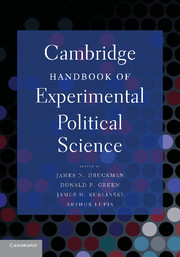Book contents
- Frontmatter
- Contents
- List of Tables
- List of Figures
- Contributors
- Acknowledgments
- INTRODUCTION
- PART I DESIGNING EXPERIMENTS
- PART II THE DEVELOPMENT OF EXPERIMENTS IN POLITICAL SCIENCE
- 6 Laboratory Experiments in Political Science
- 7 Experiments and Game Theory's Value to Political Science
- 8 The Logic and Design of the Survey Experiment
- 9 Field Experiments in Political Science
- PART III DECISION MAKING
- PART IV VOTE CHOICE, CANDIDATE EVALUATIONS, AND TURNOUT
- PART V INTERPERSONAL RELATIONS
- PART VI IDENTITY, ETHNICITY, AND POLITICS
- PART VII INSTITUTIONS AND BEHAVIOR
- PART VIII ELITE BARGAINING
- PART IX ADVANCED EXPERIMENTAL METHODS
- AFTERWORD
- Name Index
- Subject Index
- References
9 - Field Experiments in Political Science
Published online by Cambridge University Press: 05 June 2012
- Frontmatter
- Contents
- List of Tables
- List of Figures
- Contributors
- Acknowledgments
- INTRODUCTION
- PART I DESIGNING EXPERIMENTS
- PART II THE DEVELOPMENT OF EXPERIMENTS IN POLITICAL SCIENCE
- 6 Laboratory Experiments in Political Science
- 7 Experiments and Game Theory's Value to Political Science
- 8 The Logic and Design of the Survey Experiment
- 9 Field Experiments in Political Science
- PART III DECISION MAKING
- PART IV VOTE CHOICE, CANDIDATE EVALUATIONS, AND TURNOUT
- PART V INTERPERSONAL RELATIONS
- PART VI IDENTITY, ETHNICITY, AND POLITICS
- PART VII INSTITUTIONS AND BEHAVIOR
- PART VIII ELITE BARGAINING
- PART IX ADVANCED EXPERIMENTAL METHODS
- AFTERWORD
- Name Index
- Subject Index
- References
Summary
After a period of almost total absence in political science, field experimentation has become a common research design. In this chapter, I discuss some of the reasons for the increasing use of field experiments. Several chapters in this volume provide comprehensive introductions to specific experimental techniques and detailed reviews of the now extensive field experimental literatures in multiple areas. This chapter does not duplicate these contributions, but instead provides background, arguments, opinions, and speculations. I begin by defining field experiments in Section 1. In Section 2, I discuss the intellectual context for the emergence of field experimentation in political science, beginning with the recent revival of field experimentation in studies of voter turnout. In Section 3, I describe the statistical properties of field experiments and explain how the approach addresses many of the common methodological deficiencies identified in earlier observational research on campaign effects and voter participation. Section 4 reviews the range of applications of field experimentation. In Section 5, I answer several frequently asked questions about the limitations and weaknesses of field experimentation. In Section 6, I briefly discuss some challenges that field experimentation faces as it becomes a more frequently employed methodological approach in political science. This includes a discussion of the external validity of field experimental results and consideration of how difficulties related to replication and bias in experimental reporting might affect the development of field experiment literatures.
- Type
- Chapter
- Information
- Cambridge Handbook of Experimental Political Science , pp. 115 - 138Publisher: Cambridge University PressPrint publication year: 2011
References
- 18
- Cited by

